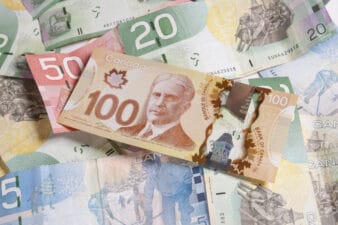The share price of BCE (TSX:BCE)(NYSE:BCE) gave up some of the 2019 gains in recent weeks, and investors who missed the rally this year are wondering if this is a good time to add the stock to their TFSA or RRSP portfolios.
Let’s take a look at the current situation to see if BCE deserves to be on your buy list.
Market conditions
BCE tends to move lower when interest rates rise and GICs pay more, and it picks up a tailwind when returns on fixed-income investments fall.
For example, the stock price dropped through most of 2018, as the Bank of Canada and the U.S. Federal Reserve raised interest rates in an effort to head off inflation and rebuild firepower to combat the next downturn. From December 2017 to October 2018, BCE’s share price fell more than 15% to $51.
In hindsight, that was a great time to buy.
The escalation of the trade war between the United States and China late last year started to hit global markets and forced the central banks to shift gears. The Bank of Canada put rate hikes on hold in 2019 and the Fed cut rates three times. The result was a rally in the bond market and a plunge in GIC rates, sending investors back to high-yield dividend stocks. BCE’s share price topped $65 in October.
Looking ahead to 2020, the U.S. Federal Reserve is expected to sit on its hands, as it evaluates the impact of the phase one trade agreement between the U.S. and China. Further progress on the negotiations and a rebound in the global economy could lead investors to anticipate a hike in 2021.
In Canada, the central bank is widely expected to lower rates in the coming year, but that might not turn out to be the case. Inflation is above the Bank of Canada’s target level, limiting its ability to move rates downward. Additional cuts could also put an additional tailwind behind the resurgent housing market.
Bond yields are starting to creep back up after a significant decline in 2019, suggesting the market is anticipating rate hikes, or at least no new cuts. The shift could be behind the drop in BCE’s share price in recent weeks.
The stock is down from $64.50 to below $61 per share. A move below $60 wouldn’t be a surprise in the near term.
Results
BCE reported solid Q3 2019 results and is expected to finish the year with earnings and free cash flow growth that meet the company’s targets.
As a result, investors will likely see a dividend hike in 2020 in the 5% range. This would be in line with the trend in recent years. At the time of writing, the stock provides a 5.25% dividend yield.
BCE is raising its internet charge by $5 per month in 2020. That doesn’t sound like much, but it adds up quickly when you have millions of accounts. Revenue growth from new products could also drive strong results next year. The expansion of home monitoring and security offerings is one area BCE might be able to boost its average bill across the subscriber base.
In addition, broadband demand should continue to rise across all platforms with the arrival of new streaming services and ongoing growth in video viewing, especially among younger consumers.
On the risk side, we could see the government start to push for lower mobile phone rates in 2020. Any ramp up of discussion and media attention on the issue could trigger a sell-off.
Should you buy BCE?
The dividend provides a yield that is 3% higher than the average three-year GIC, making it a compelling pick for income investors.
The stock could come under additional pressure if the market senses interest rates could move higher, but any additional downside should be viewed as a buying opportunity for yield-seeking investors.







